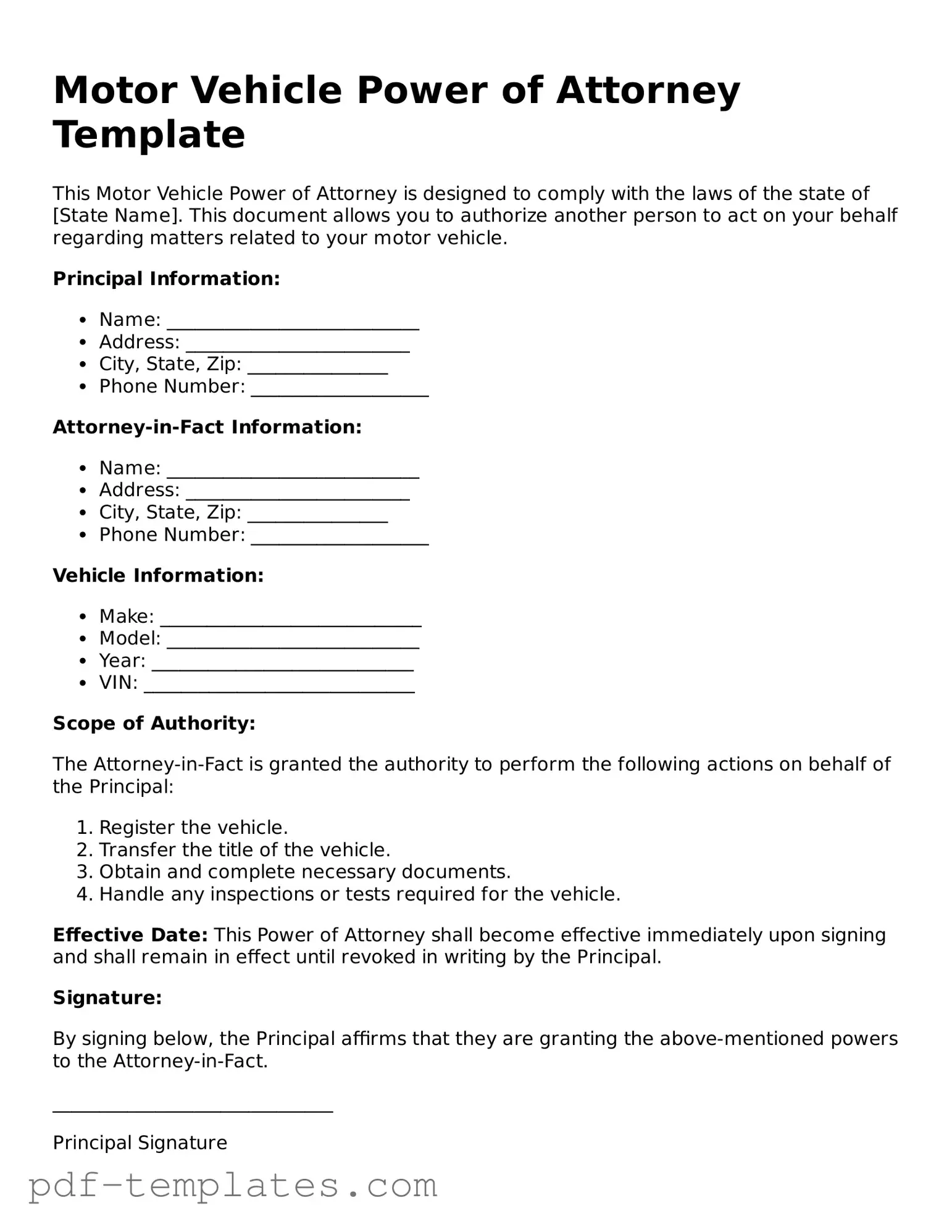The Motor Vehicle Power of Attorney form is similar to the General Power of Attorney. Both documents allow one person to grant another the authority to act on their behalf. In the case of a General Power of Attorney, the scope is broader, covering various legal and financial matters. However, the Motor Vehicle Power of Attorney is specifically tailored for matters related to motor vehicles, such as transferring titles or registering vehicles. This specificity makes it particularly useful for individuals dealing with vehicle-related transactions.
Another document that shares similarities is the Limited Power of Attorney. Like the Motor Vehicle Power of Attorney, a Limited Power of Attorney grants specific authority to act on behalf of another person, but it can cover a variety of situations beyond just vehicle matters. This document is often used when the principal wants to limit the agent's powers to particular tasks, such as handling real estate transactions or managing financial accounts. The focused nature of both documents ensures that the agent's powers are clearly defined and restricted to certain actions.
The Durable Power of Attorney is also akin to the Motor Vehicle Power of Attorney. Both forms allow an individual to designate someone else to manage their affairs. The key difference lies in the durability aspect. A Durable Power of Attorney remains in effect even if the principal becomes incapacitated, while the Motor Vehicle Power of Attorney typically does not. This distinction is crucial for individuals who want to ensure that their vehicle-related matters can be handled at any time, including during periods of incapacity.
The Vehicle Title Transfer form is another document that relates closely to the Motor Vehicle Power of Attorney. While the latter allows someone to act on behalf of another in vehicle transactions, the Vehicle Title Transfer form is specifically used to officially transfer ownership of a vehicle from one party to another. Both documents are essential in the vehicle transaction process, but the Power of Attorney provides the necessary authority for the agent to complete the transfer on behalf of the owner.
The Bill of Sale for a vehicle shares similarities with the Motor Vehicle Power of Attorney as well. A Bill of Sale is a legal document that records the sale of a vehicle and includes details such as the buyer, seller, and vehicle description. While the Motor Vehicle Power of Attorney allows someone to act on another's behalf during the sale process, the Bill of Sale formalizes the transaction itself. Together, they ensure that both the authority to sell and the sale itself are properly documented.
Another comparable document is the Vehicle Registration Application. This form is used to register a vehicle with the state, ensuring that it is legally recognized for use on public roads. The Motor Vehicle Power of Attorney can be used to authorize someone else to complete this registration on behalf of the vehicle owner. Both documents are essential for ensuring that a vehicle is legally compliant, but they serve different roles in the process.
When dealing with the complexities of vehicle transactions, it's important to understand not only the Motor Vehicle Power of Attorney but also the related documents that facilitate these processes. For instance, the California Notary Acknowledgement form plays a vital role in ensuring the legitimacy of signatures on crucial documents, enhancing trust in legal transactions. Therefore, individuals handling vehicles may find it beneficial to familiarize themselves with All California Forms to ensure they have the necessary documentation and legal assurances in place.
Lastly, the Release of Liability form is similar in that it is often used in vehicle transactions. This form protects the seller from future liabilities related to the vehicle after it has been sold. While the Motor Vehicle Power of Attorney allows an agent to manage the sale or transfer of the vehicle, the Release of Liability ensures that the seller is no longer responsible for the vehicle once the transaction is complete. Both documents are vital in protecting the interests of the parties involved in vehicle transactions.
